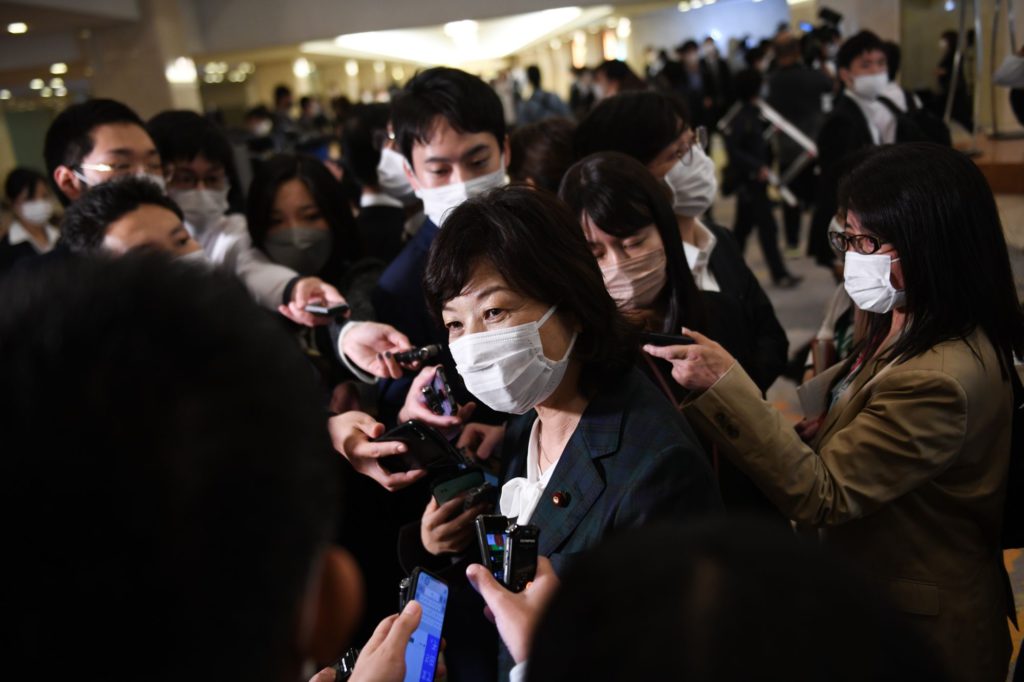(Bloomberg) — Japan’s Fumio Kishida was appointed prime minister by parliament Monday, and is set to reveal a new cabinet lineup as he seeks to revive support for his ruling party ahead of a general election that could likely come this month.
The ruling Liberal Democratic Party used its majority to formally elect Kishida, who will be the second premier in about a year, and is looking to hold a national election on Oct. 31, national public broadcaster NHK and Kyodo News said Monday, with an upper house vote due next year.
Most of the new cabinet members have already been reported by domestic media and the incoming premier may struggle to attract voter interest given most members of his team are party veterans. After pledging to appoint younger lawmakers, he is set to remove 81-year-old Finance Minister Taro Aso from his post, replacing him with former Olympics Minister Shunichi Suzuki, 68.
Kishida was not the public’s top choice for the job and now he must try to win over voters frustrated with the government’s coronavirus policies. Due to the LDP’s powerful political machine, its ruling coalition is all but certain to retain a parliamentary majority, but any major gains by the opposition could hobble Kishida from the start, and increase the odds he joins a long list of short-serving premiers.
While none of the opposition parties have support of more than single figures, they plan to work together in many constituencies to chip away at the ruling coalition’s majority in the election.
Japan’s Incoming Finance Minister Suzuki in His Own Words
Kishida, who has conceded some see him as boring, won the LDP leadership race last week over three opponents, including former vaccine czar Taro Kono, who was the public’s top choice for prime minister. Kishida’s new team will need to help revive the pandemic-hit economy and find a way to balance ties between China, the country’s biggest trade partner and the U.S., its only treaty ally.
The timing of the election may affect Kishida’s plans for a debut on the world stage. He is set to skip the Group of 20 summit in Italy on Oct. 30-31, but will attend the COP26 climate meeting in the U.K., the leaders’ section of which starts Nov. 1, Kyodo said Monday.
Kishida has pledged to create a minister of economic security as the country seeks to bolster its semiconductor industry, amid worldwide shortages. He’s also vowed to help raise incomes among the middle class.
“We must improve our ability to communicate with the people, and based on that the prime minister must put into practice the policies he’s promised as soon as possible,” LDP Secretary General Akira Amari told NHK after Kishida was approved by parliament.
In a good sign for Kishida, data last week showed confidence among big Japanese businesses unexpectedly improved for a fifth straight quarter, defying a record wave of coronavirus infections and suggesting a potentially faster recovery under the nation’s new prime minister. Virus infections have tumbled over the past few weeks, and the lifting of a state of emergency means a likely boost for bars, restaurants and the travel industry.
The male-dominated LDP has struggled for years with gender equality and Kishida is set to appoint three women to his new cabinet — expected to be 20 members, media reports said. The highest-profile spots have been allocated to men, with Foreign Minister Toshimitsu Motegi expected to keep his job, according to Kyodo News, while Defense Minister Nobuo Kishi is also set to stay on, according to the Yomiuri newspaper.
One barrier to appointing more women as ministers is the dearth of female candidates in the party as a whole. About 10% of lower house lawmakers are women, while among LDP representatives the figure is less than 8%.
Seiko Noda, a female former internal affairs minister who ran against Kishida in the LDP race, is expected to join the cabinet as minister for tackling the low birth rate and reviving the regions, NHK said. Kishida appointed his two other rivals, Kono and Sanae Takaichi, to LDP executive positions.
Support for the long-dominant LDP had sagged under outgoing premier Yoshihide Suga, amid criticism of his handling of the coronavirus, and began to rise after he announced he would step down after about a year in the post.
“It’s like a triathlon,” Hideki Murai, an LDP lawmaker and member of Kishida’s faction, told Bloomberg last week. “Winning the party leadership is just like completing the swim. Only when he’s finished the bike ride, which is the lower house election and the run, which is the upper house election, will he have a stable administration.”
(Updates with formal election in parliament.)
More stories like this are available on bloomberg.com
©2021 Bloomberg L.P.











